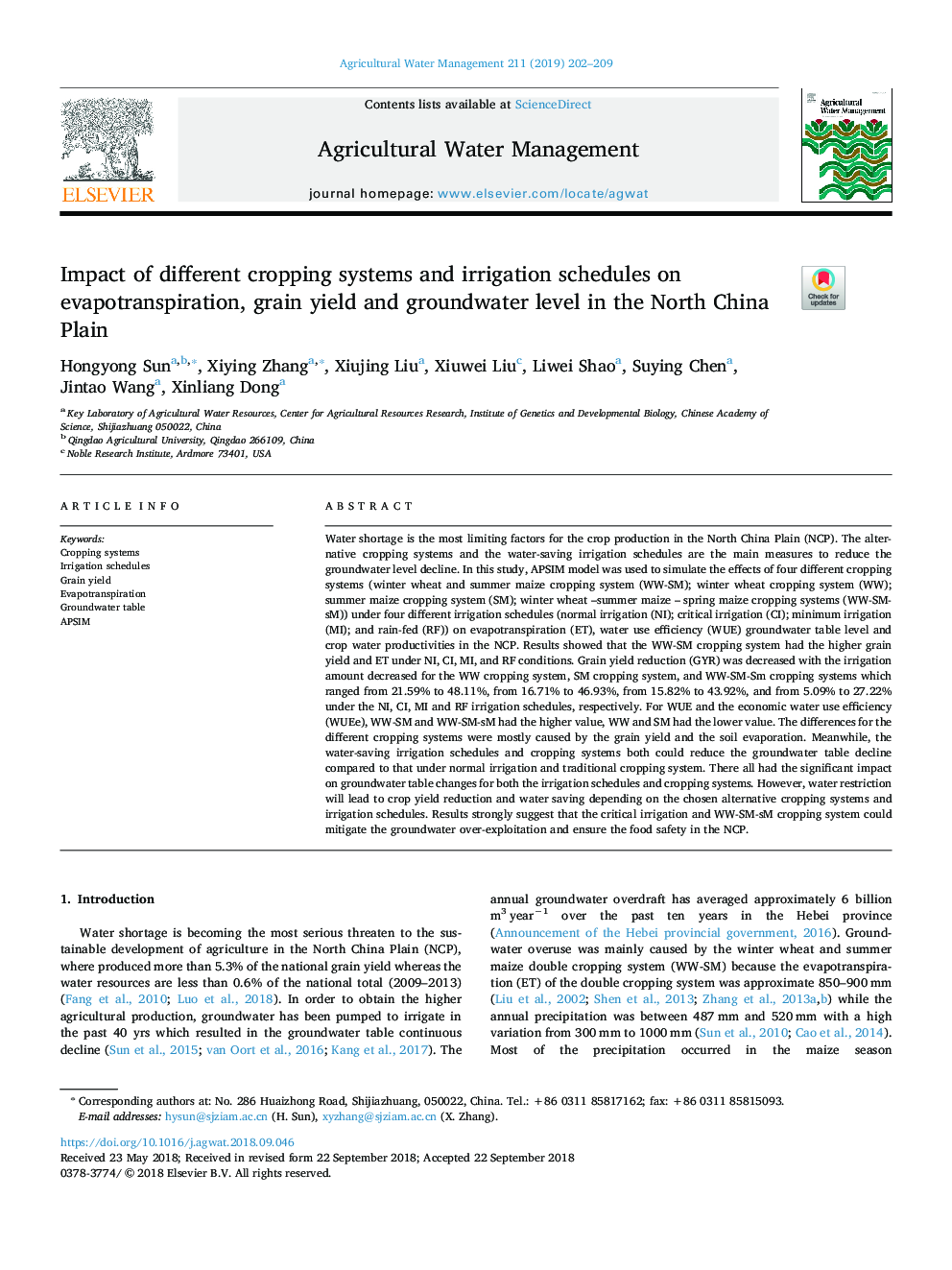| کد مقاله | کد نشریه | سال انتشار | مقاله انگلیسی | نسخه تمام متن |
|---|---|---|---|---|
| 11021764 | 1702818 | 2019 | 8 صفحه PDF | دانلود رایگان |
عنوان انگلیسی مقاله ISI
Impact of different cropping systems and irrigation schedules on evapotranspiration, grain yield and groundwater level in the North China Plain
ترجمه فارسی عنوان
تأثیر سیستم های زراعی و برنامه های آبیاری مختلف بر تبخیر و تعرق، عملکرد دانه و سطح آب زیرزمینی در شمال جلگه چین
همین الان دانلود کنید
دانلود مقاله ISI انگلیسی
رایگان برای ایرانیان
کلمات کلیدی
سیستم های کشت، برنامه های آبیاری، عملکرد دانه، تبخیر و تعرق، سفره¬ی آبهای زیرزمینی، APSIM
فهرست مطالب مقاله
چکیده
کلمات کلیدی:
1. معرفی
2. مواد و روش ها
2.1. محل مطالعه
2.2. شبیه سازی سیستم های مختلف کشت تحت برنامه های مختلف آبیاری
2.3 داده ها
2.4 مدل APSIM و پارامترهای آن
2.5. خالص مصرف آب
2.6. راندمان مصرف آب
2.7 روش های آماری داده¬ها
3. نتایج
3.1 مصرف آب
3.2 عملکرد دانه
3.3. راندمان مصرف آب
3.4 آب زیرزمینی
4- بحث و نتیجه گیری
جداول و شکل ها
کلمات کلیدی:
1. معرفی
2. مواد و روش ها
2.1. محل مطالعه
2.2. شبیه سازی سیستم های مختلف کشت تحت برنامه های مختلف آبیاری
2.3 داده ها
2.4 مدل APSIM و پارامترهای آن
2.5. خالص مصرف آب
2.6. راندمان مصرف آب
2.7 روش های آماری داده¬ها
3. نتایج
3.1 مصرف آب
3.2 عملکرد دانه
3.3. راندمان مصرف آب
3.4 آب زیرزمینی
4- بحث و نتیجه گیری
جداول و شکل ها
ترجمه چکیده
کمبود آب محدود کننده ترین عامل تولید محصول در شمال جلگه چین (NCP) است. روش های زراعی جایگزین و برنامه های آبیاری مناسب اقدامات اصلی جهت کاهش افت سطح آب زیرزمینی است. در این مطالعه برای شبیه سازی اثرات چهار سیستم زراعی مختلف (سیستم زراعی گندم زمستانه و ذرت تابستانه (WW-SM)، سیستم زراعی گندم زمستانه (WW)؛ سیستم زراعی ذرت تابستانه (SM)؛ سیستم های زراعی گندم زمستانه - ذرت تابستانه - ذرت بهاره (WW-SMsM) با چهار برنامه آبیاری مختلف (آبیاری نرمال (NI)؛ آبیاری بحرانی (CI)؛ آبیاری حداقلی (MI)؛ و آبیاری با آب باران (RF)) بر تبخیر و تعرق (ET)، راندمان مصرف آب (WUE) سطح سفره های آب زیرزمینی و بهره-وری آب زراعی در NCP از مدل APSIM استفاده شد. نتایج نشان داد که سیستم زراعی WW-SM در شرایط NI ، CI ، MI و RF عملکرد دانه و ET بالاتری داشت. كاهش عملكرد دانه (GYR) با كاهش مقدار آبياري سيستم زراعی WW، سيستم زراعی SM و سیستم های زراعی WW-SM-Sm کاهش یافت كه در برنامه های آبیاریNI ،CI ، MI و RF به ترتیب از 21.59٪ تا 48.11٪ ، از 16.71٪ تا 46.93٪، از 15.82% تا 92/43% و از 5.09 تا 27.22% مرتب شد. WUE و راندمان مصرف آب اقتصادی (WUEe) در WW-SM و WW-SM-sM بیشتر و در WW و SM پایین تر بودند. اختلاف سیستم های زراعی مختلف بیشتر مربوط به عملکرد دانه و تبخیر خاک بود. بعلاوه، برنامه های آبیاری مناسب (صرفه جویی در آب) و سیستم های زراعی هر دو می توانند افت سطح سفره ی آب های زیرزمینی را در مقایسه با برنامه آبیاری معمولی و سیستم زراعی سنتی کاهش دهند. همگی تأثیر قابل توجهی بر تغییرات سفره ی آبهای زیرزمینی هم برای برنامه های آبیاری و هم برای سیستم های زراعی داشتند. با این وجود، محدودیت آب، بسته به سیستم های زراعی جایگزین و برنامه های آبیاری انتخاب شده منجر به کاهش عملکرد محصول و صرفه جویی در مصرف آب خواهد شد. نتایج کاملا نشان می دهند که آبیاری بحرانی و سیستم زراعی WW-SM-sM توانستند مصرف بیش از حد آب زیرزمینی را کاهش داده و امنیت غذایی در NCP را تضمین کنند.
موضوعات مرتبط
علوم زیستی و بیوفناوری
علوم کشاورزی و بیولوژیک
علوم زراعت و اصلاح نباتات
چکیده انگلیسی
Water shortage is the most limiting factors for the crop production in the North China Plain (NCP). The alternative cropping systems and the water-saving irrigation schedules are the main measures to reduce the groundwater level decline. In this study, APSIM model was used to simulate the effects of four different cropping systems (winter wheat and summer maize cropping system (WW-SM); winter wheat cropping system (WW); summer maize cropping system (SM); winter wheat -summer maize - spring maize cropping systems (WW-SM-sM)) under four different irrigation schedules (normal irrigation (NI); critical irrigation (CI); minimum irrigation (MI); and rain-fed (RF)) on evapotranspiration (ET), water use efficiency (WUE) groundwater table level and crop water productivities in the NCP. Results showed that the WW-SM cropping system had the higher grain yield and ET under NI, CI, MI, and RF conditions. Grain yield reduction (GYR) was decreased with the irrigation amount decreased for the WW cropping system, SM cropping system, and WW-SM-Sm cropping systems which ranged from 21.59% to 48.11%, from 16.71% to 46.93%, from 15.82% to 43.92%, and from 5.09% to 27.22% under the NI, CI, MI and RF irrigation schedules, respectively. For WUE and the economic water use efficiency (WUEe), WW-SM and WW-SM-sM had the higher value, WW and SM had the lower value. The differences for the different cropping systems were mostly caused by the grain yield and the soil evaporation. Meanwhile, the water-saving irrigation schedules and cropping systems both could reduce the groundwater table decline compared to that under normal irrigation and traditional cropping system. There all had the significant impact on groundwater table changes for both the irrigation schedules and cropping systems. However, water restriction will lead to crop yield reduction and water saving depending on the chosen alternative cropping systems and irrigation schedules. Results strongly suggest that the critical irrigation and WW-SM-sM cropping system could mitigate the groundwater over-exploitation and ensure the food safety in the NCP.
ناشر
Database: Elsevier - ScienceDirect (ساینس دایرکت)
Journal: Agricultural Water Management - Volume 211, 1 January 2019, Pages 202-209
Journal: Agricultural Water Management - Volume 211, 1 January 2019, Pages 202-209
نویسندگان
Hongyong Sun, Xiying Zhang, Xiujing Liu, Xiuwei Liu, Liwei Shao, Suying Chen, Jintao Wang, Xinliang Dong,
